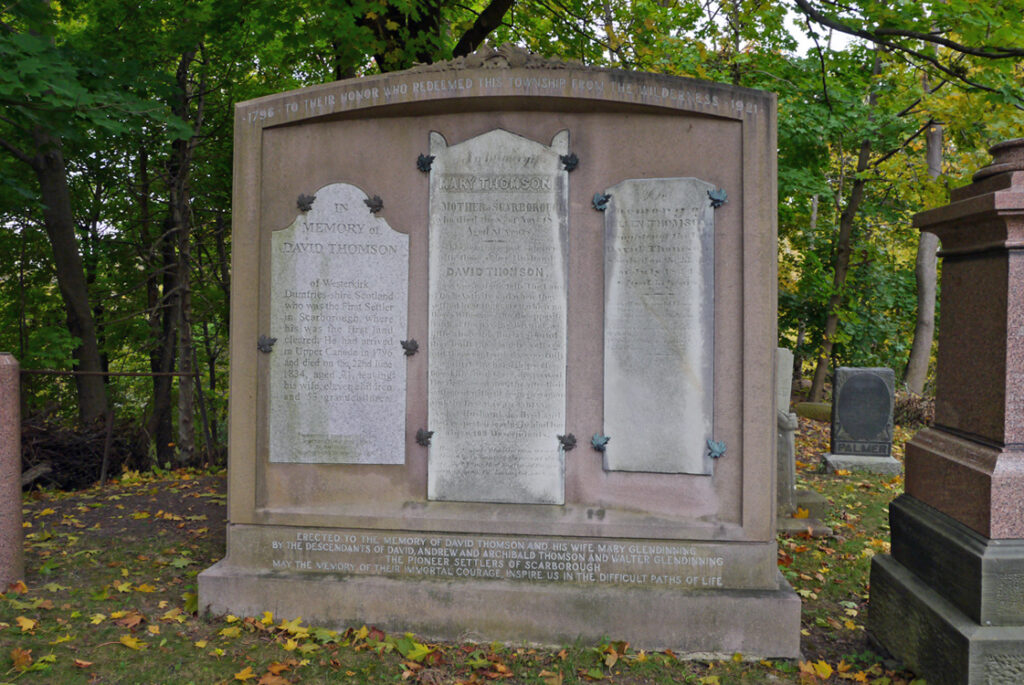There is a plaque in St. Andrews Presbyterian Church cemetery, Scarborough, Ontario commemorating the community’s pioneer settlers David Thompson, his wife Mary Glendinning, and Walter Glendinning.
David and Mary are still well remembered in Scarborough, but Walter Glendinning is not. I wondered whether he was Mary’s brother — and my three-times great-grandfather.
Many of Scarborough’s early settlers came from Westerkirk, Dumfriesshire, or from other areas of lowland Scotland. Many of them were related to, or friends of, the Thompsons, and likely immigrated to Canada thanks to the pioneer couple’s encouragement. Mary’s brother James Glendinning immigrated to Streetsville, Ontario and her brother William settled in New Brunswick.

Mary’s brother Walter (1770 – ?) married Elizabeth Park in 1794. The couple had nine children, most of whose baptismal records can be found in the old parish registers of the Church of Scotland in Westerkirk. There is evidence from marriage, death and census records that at least six of these people lived in Scarborough.
The children of Walter and Elizabeth were:
James Glendinning, b. 1796 Westerkirk, m. Eliza Jane Wilkinson, farmer Scarborough, concession II, lot 23; d. 1861, Scarborough. (St Andrews Cemetery)
Janet Glendinning, b. 1798 Westerkirk, no further info.
Andrew Glendinning, b. 1800 Westerkirk, no further info.
William Glendinning, b. 1802 Westerkirk, m. Elizabeth Borthwick, farmed with brother Archibald, concession I, lot 29, Scarborough.
Archibald Glendinning, b. 1804, m. Jean Stobo, 1834; Scarborough farmer, concession I, lot 29; store owner, postmaster, community volunteer, d. 1883, Scarborough. (St. Andrews Cemetery)
John Glendinning, b. 1807, Westerkirk, m. Margaret Whiteside, Scarborough, farmer lot 35, concession 5, d. 1855. My direct ancestor. (St Andrews Cemetery)
Walter Glendinning, b. 1809, Westerkirk, no further info.
Isabel Glendinning, b. 1814, Westerkirk, d. 1832, Scarborough, age 17. (St Andrews Cemetery)
Margaret Glendinning, b. 1819, Westerkirk, m. Andrew Bertram, Toronto, 1839, farmer, lived in Scarborough and Innisfil, Simcoe. I do not have other information about her.
Before I started researching this family, I wondered whether just the younger generation immigrated, or whether Walter and Elizabeth also came to Canada. Assuming that the family immigrated together in the mid-1820s, the youngest of the children would have been quite small, so it seems unlikely that the parents would have stayed behind in Scotland.
It usually took settlers several years of farming rented property before they had enough money to buy their own land. Members of the Glendinning family bought their first land in 1829, so they had probably been in Canada for a few years at that time.
The Ontario land records show that William Glendinning purchased part of Concession I Lot 29 and half of Concession I Lot 30 in 1829. Meanwhile, Archibald Glendinning purchased the other half of Concession I Lot 30 in 1829 and, much later, in 1861, he purchased Concession I Lot 28. My direct ancestor John Glendinning purchased Concession V Lots 34 and 35 in 1850. There is no record of Walter Glendinning buying land, so perhaps he lived on a rented farm, or perhaps he lived with one of his sons.
The 1837 directory of the City of Toronto and the Home District listed five Glendinnings in Scarborough. Walter was listed on Concession 1, lot 28, however, it is not clear whether this was Walter the father or the son. The directory only listed household heads and there was no census taken in these early years of settlement.
There was also a mention of a Walter Glendinning in the records of St. Andrews Presbyterian Church, dated July 1, 1837, suspending him from the sacrament.
The main problem is that I have not found death records for Walter Glendinning the father, or for his wife Elizabeth Park. If they were buried in St. Andrews Presbyterian Church Cemetery in Scarborough, their grave has disappeared. If they died before the children left Scotland, they probably could not afford a gravestone.
As for Walter the son, he may have died young in Scotland, he may have accompanied the family to Scarborough, or he may have moved elsewhere.
In the meantime, my tentative conclusion to the question, who was Walter Glendinning the pioneer, is that it was Mary’s brother and my direct ancestor.
See also:
Janice Hamilton, Writing Up the Ancestors, “The Glendinnings of Scarborough,” https://www.writinguptheancestors.ca/2016/12/the-glendinnings-of-scarborough.html
Notes and Footnotes
The basic genealogy of this family is thanks to Ian Glendinning of Aberdeen, Scotland, who has put together an extensive family tree of the Glendinnings from Westerkirk http://www.glendinning.name/ancestry/glenfam/pafg01.htm#320.
George Walton, City of Toronto and the Home District Commercial Directory and Register with almanac and calendar for 1837; http://static.torontopubliclibrary.ca/da/pdfs/706129.pdf
St. Andrews Presbyterian Cemetery (Bendale), Scarborough, Ontario. A genealogical reference listing. Ontario Genealogical Society, Toronto Branch. 1988 and 1993. (There are two Walter Glendinnings included in the transcriptions of gravestones at St. Andrews Cemetery, but neither of them is this Walter. They are: Walter Glendinning, son of James and Eliza; and Walter Glendinning, d. 1892, and his wife Isabella Robertson; he was born 1849 in Scarborough, son of Archibald.)
Thanks also to Rick Scholfield, archivist at the Scarborough Archives.
